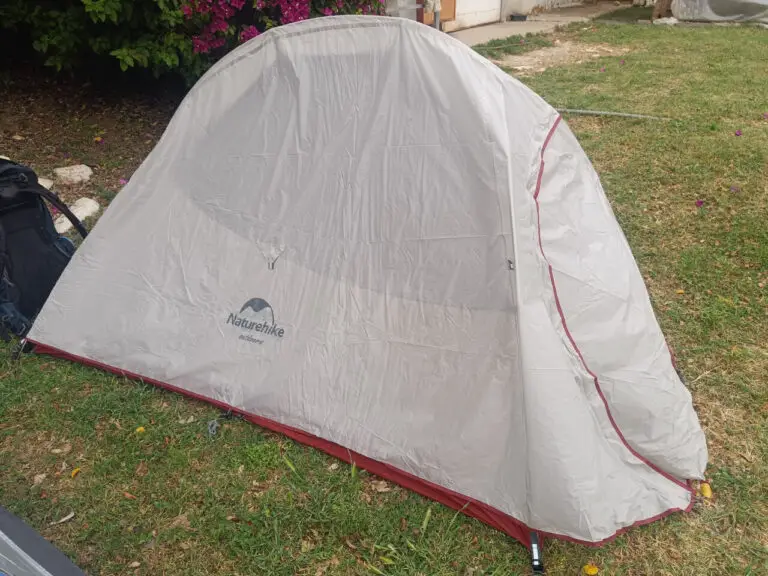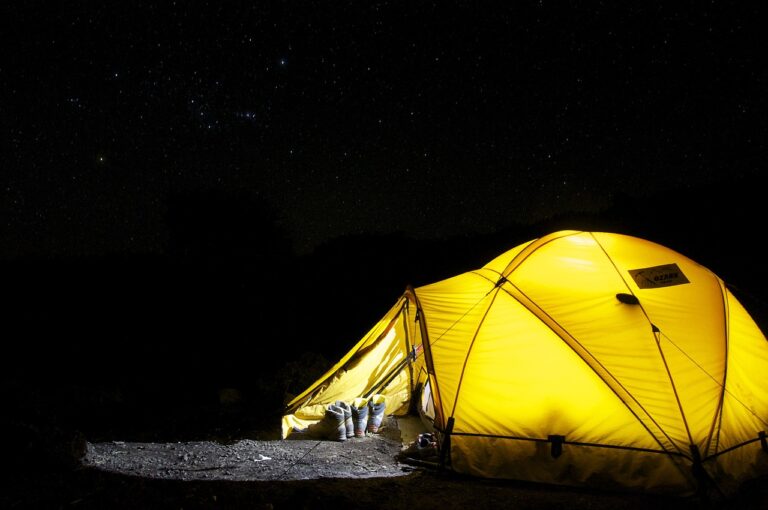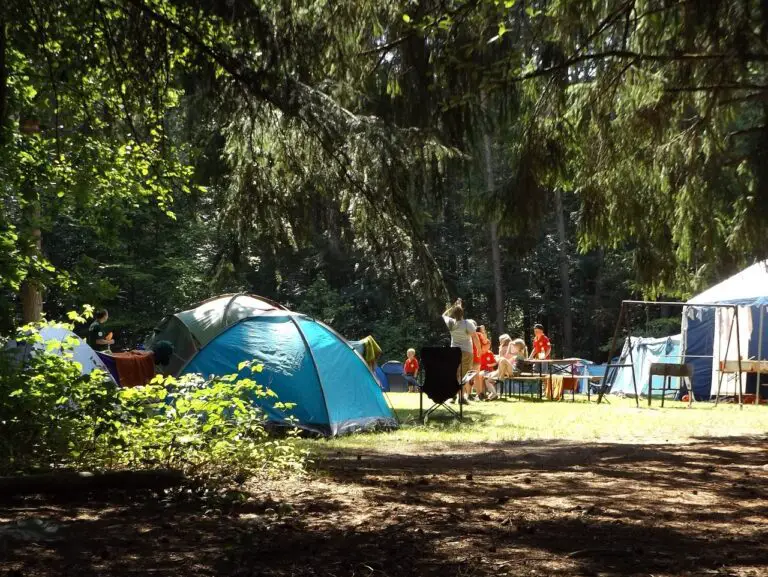What Size Tent Do You Need? We Analyzed Over 130 Tents!
When planning a backpacking or camping trip, a significant consideration is how big of a tent to bring. We all had the experience of feeling like sardines because someone forgot to check the size of the tent. So what size camping tent do you need?
As a general rule, your tent area should be at least 10 square feet for each adult, and at least 7 square feet for each kid, not including gear.
But you might want a more complete answer, with specific numbers related to your sleeping situation. The rest of this post will answer all your questions in detail.
Understanding Tent Sizes
When hiking, we generally try to keep our equipment to a minimum. This means taking exactly what we need. Generally, bigger tents are also heavier, so when backpacking you’ll try to take the smallest tent which is still comfortable.
Standard tent specs include multiple measurements:
- Length and Width: the length and width of the floor of the tent, including the inside area and the vestibule.
- Floor Area: the total area of the tent, including the inside area and the vestibule.
- Vestibule Area: the area of the tent vestibule.
I’ve gathered information from online retailers about tents and sleeping pad sizes, and estimated the minimal tent size you’ll need, based on the number of people, gear, and more.
Tent Area By Sleeping Capacity
Most tents are marketed by sleeping capacity rating. This rating is supposed to indicate the number of people that can tightly sleep in the tent. These ratings are usually considered optimistic, meaning tents feel tighter than indicated.
I’ve gathered information on more than 130 tents from an online retailer((The analysis is based on public information from REI)). I then grouped the tents by their sleeping capacity and estimated the sleeping area inside the tent and the vestibule area based on the rating.
The resulting tent dimensions table showcases how big tents are by their sleeping capacity:
| Sleeping Capacity | Average Length (inches) | Average Width (inches) | Average Floor Area (square feet) | Average Inside Area (square feet) | Vestibule Area (square feet) |
| 1-Person | 86.2 | 36.1 | 19.4 | 11.8 | 7.6 |
| 2-Person | 87.2 | 52.9 | 32.1 | 21.7 | 10.4 |
| 3-Person | 92.0 | 68.7 | 43.8 | 33.8 | 9.9 |
| 4-Person | 89.2 | 88.4 | 55.1 | 44.8 | 10.3 |
Some tents are marketed as backpacking tents and some as camping tents. Based on this analysis, camping tents are typically bigger by a small margin.
Sleeping Pads Size
To calculate how much space each person takes, I analyzed the average size of sleeping pads((I performed an analysis based on sleeping pad sizes in REI.)).
The average sleeping pad is 72 inches long and 20 inches wide. This means each sleeping pad takes around 10 square feet. Some sleeping pads can have different lengths or widths, based on the preferences of the camper.
This table splits sleeping pads into different categories and averages the dimensions of sleeping pads in that category. It showcases how big sleeping pads are by their type:
| Sleeping pad type | Average sleeping pad length (inches) | Average sleeping pad width (inches) | Average sleeping pad area (square feet) |
| Regular | 72 | 21 | 10.3 |
| Regular Wide | 72 | 25 | 12.7 |
| Long | 78 | 24 | 12.8 |
| Short (3/4) | 54 | 21 | 7.9 |
In our analysis, for simplicity, we’ll use regular sleeping pads as our frame of reference. If your sleeping pad is sized differently, you should consider that.
Tent Size By Number Of People
Now that we analyzed the typical sizes of tents by their marketed sleeping capacity, we can consider our conclusions.
We have to note that as we know, these marketed figures might be a bit optimistic. So it’s best to actually physically check the dimensions of your tent and not rely on the specs. Let these conclusions be a general rule of thumb.
Based on the estimated tents’ inside areas, and the sleeping pad area, we can estimate the number of sleeping pads that can fit in a tent by the sleeping capacity:
| Sleeping Capacity | Average Inside Area (square feet) | Number Of Regular Sleeping Pads |
| 1-Person | 11.8 | 1.14 |
| 2-Person | 21.7 | 2.10 |
| 3-Person | 33.8 | 3.28 |
| 4-Person | 44.8 | 4.35 |
Based on this information, we can find how many people can fit inside each type of tent.
What size tent for one adult?
One adult can comfortably fit in a 1-person tent with the gear in the vestibule or a 2-person tent with the gear stored inside.
What size tent for two adults?
Two adults can tightly fit in a 2-person tent with their gear in the vestibule or comfortably fit in a 3-person tent with their gear stored inside.
What size tent for three adults?
Three adults can tightly fit in a 3-person tent with their gear in the vestibule or comfortably fit in a 4-person tent with their gear stored inside.
What size tent for four adults?
Four adults can tightly fit in a 4-person tent with their gear stored in the vestibule.
What size tent for a family of 3?
A family of 3 (two adults and a small child) can very comfortably fit in a 3-person tent with their gear in the vestibule or a 4-person tent with their gear stored inside.
What size tent for a family of 4?
A family of 4 (two adults and two small children) can tightly fit in a 4-person tent with their gear stored inside.
Comfortable vs. Light Tent Size
There are a few factors you should consider when deciding when to opt for comfort and get a bigger tent or go for a lighter but tighter tent:
- Trip difficulty and duration: Harder and longer trips require you to go with lighter gear, to avoid straining yourself. If you’re planning a short camping trip you can get away with getting a bigger tent, but hikers going on a long trek should get a tight lightweight tent.
- Hikers and sleeping pads size: Bigger hikers typically get bigger sleeping pads, and require more sleeping space. Additionally, if you prefer a wide sleeping pad, you’ll need to get a bigger tent.
- Gear storage: If you’re traveling to a remote location you’ll probably feel more comfortable storing your gear in the vestibule than in a crowded camping site.
If you’re planning to spend a lot of time in the tent, it makes sense to get a bigger, more comfortable tent, even if it’s heavier. For example, you should opt for a bigger tent for camping trips where you and your family spend the weekend at the camping site.
On trips where every ounce of weight counts, like a long trek, are situations where you should probably sacrifice comfort for weight. The relationship of the hikers is also important, so if you’re comfortable with sleeping tightly, you can get a smaller tent.
Conclusions
We’ve analyzed the sized of standard backpacking and camping tents, and found the recommended number of people that can fit in each capacity tent.
For hiking, it’s usually recommended that you go light, even if that means sacrificing sleeping comfort. Of course, that’s up for preference.
Have fun camping!







